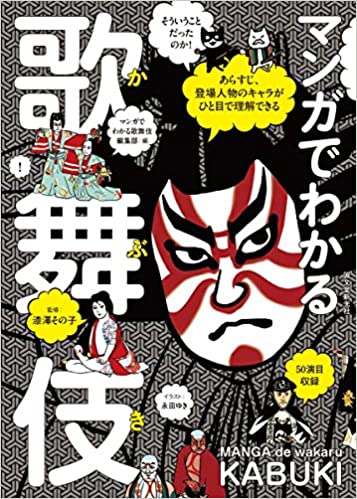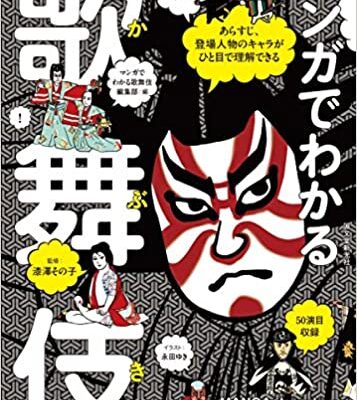漆澤その子 監修「マンガでわかる歌舞伎」 誠文堂新光社
今まで歌舞伎は舞台でも、テレビでも見たことがないので、全くの初心者です。それでも日本文化を解説する資料には含まれているので、基礎知識だけは身に付けておきたいと常々考えていました。一応、テレビの録画で勧進帳は取ってあるのですが、なかなか観る気になれませんでした。
書店で、この「マンガでわかる歌舞伎」を手にしたとき、とりあえず買っておこうと思い、しばらく自宅の本棚に寝かせていましたが、なかなか読みださないので、事務所の机の上に置くようにして、1日4ページほど無理にでも読むようにしました。
Part1の「歌舞伎を観る前に」では、演目の種類、登場人物の主な役割(立役、敵役、女性役)、独特の演出、舞台装置などの超基本的な説明がなされます。その後、Part2では50の演目について解説されます。
人物相関図とあらすじが最初に示され、マンガにてストーリーの概略を見開き4ページにて紹介しています。また、そのストーリーにまつわる話などを、マンガのコマ割りの下に説明書きとして書かれています。助六、勧進帳、忠臣蔵など、歌舞伎を見たことがなくても名前ぐらいは聞いたことがある演目から始まり、50の演目について説明しています。
ストーリーを読んでいると、話の筋は追えるのですが、今と感覚が異なるところが多々あると感じます。なぜ、そこで死ぬの?という場面が多く、頭が混乱してしまいます。江戸時代に人気を博した物語が多く紹介されていますが、日本人の考え方、特に死生観が非常に大きく変わっていることに驚かされます。
この辺りを訪日外国人に説明するのは、難しいと思うので、やはり衣装や独特の動きについての話に留めておいた方が無難なのかなと感じた次第です。シェークスピアのロミオとジュリエットも簡単に死を選んでしまうことを考えると、物語ということで、あまり深く考えなくて良いのかもしれませんが。
時々、南禅寺にも海外の方をお連れして、三門にも上るので、そこで石川五右衛門が「絶景かな、絶景かな」と台詞を吐くシーンを、舞台の写真を示して説明しても面白いかなと感じています。今度機会があれば、一度試してみます。(完)

マンガでわかる歌舞伎 あらすじ、登場人物のキャラがひと目で理解できる [ 漆澤 その子 ]
価格:1,760円
(2021/5/5 13:57時点)
感想(1件)
“Manga de wakaru Kabuki” supervised by Sonoko Urushizawa, Seibundoshinkosha
I have never seen Kabuki before, either on stage or on TV, so I am a complete beginner. Nevertheless, I have always wanted to acquire at least a basic knowledge of Kabuki since it is included in the materials explaining Japanese culture. In the meantime, I have a TV recording of Kanjincho, but I couldn’t bring myself to watch it.
When I picked up a copy of “Understanding Kabuki through Comics” at a bookstore, I thought I would just buy it and let it sit on my bookshelf at home for a while, but I didn’t start reading it, so I put it on my desk in my office and forced myself to read about four pages a day.
Part 1, “Before Watching Kabuki,” gives a very basic explanation of the types of plays, the main roles of the characters (tachiyaku, antagonist, female roles), the unique staging, and the stage sets. Then, in Part 2, the 50 plays will be explained.
A character sketch and synopsis are presented first, followed by a four-page spread outlining the story in manga. In addition, the stories related to the stories are written as explanatory notes below the manga panels. The book begins with Sukeroku, Kangencho, Chushingura, and other plays that you may have heard of even if you have never seen Kabuki, and then explains 50 plays.
When I read the story, I can follow the storyline, but I feel that there are many things that feel different from now. There are many scenes that make me wonder, “Why does he die there? There are many scenes that make me confused. Many stories that were popular in the Edo period are introduced in this book, and I was surprised to find that Japanese people’s way of thinking, especially their view of life and death, has changed drastically.
It would be difficult to explain this area to foreigners visiting Japan, so I felt it would be safer to talk about the costumes and unique movements. Considering the fact that Shakespeare’s Romeo and Juliet also chose to die easily, it is probably not necessary to think too much about the story.
I sometimes take overseas visitors to Nanzenji Temple and go up to the Sanmon gate, and I feel it would be interesting to show a picture of the stage and explain the scene where Ishikawa Goemon says the words, “Is it a beautiful view? If I have a chance, I’ll try it out. (End)
“Manga de wakaru Kabuki” supervisé par Sonoko Urushizawa, Seibundoshinkosha
Je n’ai jamais vu de Kabuki auparavant, que ce soit sur scène ou à la télévision, je suis donc un débutant complet. Néanmoins, j’ai toujours voulu acquérir au moins une connaissance de base du Kabuki puisqu’il est inclus dans les documents expliquant la culture japonaise. En attendant, j’ai un enregistrement télévisé de Kanjincho, mais je n’ai pas pu me résoudre à le regarder.
Lorsque j’ai pris un exemplaire de “Understanding Kabuki through Comics” dans une librairie, je pensais simplement l’acheter et le laisser reposer sur mon étagère à la maison pendant un certain temps, mais je n’ai pas commencé à le lire, alors je l’ai mis sur mon bureau et je me suis forcé à lire environ quatre pages par jour.
La première partie, “Avant de regarder le Kabuki”, donne une explication très basique des types de pièces, des rôles principaux des personnages (tachiyaku, antagoniste, rôles féminins), de la mise en scène unique et des décors de scène. Ensuite, dans la deuxième partie, les 50 pièces seront expliquées.
Une esquisse de personnage et un synopsis sont présentés en premier, suivis d’une planche de quatre pages décrivant l’histoire en manga. En outre, les histoires liées aux récits sont écrites sous forme de notes explicatives sous les panneaux manga. Le livre commence par Sukeroku, Kangencho, Chushingura et d’autres pièces dont vous avez peut-être entendu parler même si vous n’avez jamais vu de Kabuki, puis explique 50 pièces.
Lorsque je lis l’histoire, je peux suivre le scénario, mais j’ai l’impression qu’il y a beaucoup de choses qui sont différentes de maintenant. Il y a beaucoup de scènes qui me font me demander : “Pourquoi meurt-il là ? De nombreuses scènes me laissent perplexe. De nombreuses histoires populaires à l’époque d’Edo sont présentées dans ce livre, et j’ai été surpris de constater que la façon de penser des Japonais, notamment leur vision de la vie et de la mort, a radicalement changé.
Il serait difficile d’expliquer ce domaine à des étrangers visitant le Japon, j’ai donc pensé qu’il serait plus sûr de parler des costumes et des mouvements uniques. Compte tenu du fait que le Roméo et la Juliette de Shakespeare ont également choisi de mourir facilement, il n’est probablement pas nécessaire de trop réfléchir à l’histoire.
J’emmène parfois des visiteurs étrangers au temple Nanzenji et je monte jusqu’à la porte Sanmon. Je pense qu’il serait intéressant de montrer une photo de la scène et d’expliquer la scène où Ishikawa Goemon dit les mots “Est-ce une belle vue ? Si j’ai l’occasion, je vais essayer. (Fin)
